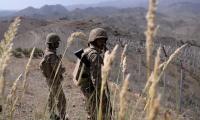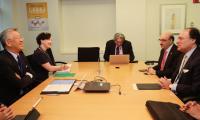Two notable and powerful city states in ancient Greece were Athens and Sparta: two political entities representing contrasting ways of life. While Athens was the bastion of democracy, freedom of expression, commerce, philosophy and the arts, Sparta had an oligarchic and militaristic political system that valued discipline and regimentation and barred its citizens from taking to trade or manufacture.
The two states went through the generation-long, devastating war known as the Peloponnesian War (431–404 BC), in which Sparta finally triumphed over Athens and emerged as the leading Greek power. The triumph of Sparta has been seen by many as the victory of oligarchy over democracy; of authoritarianism over freedom; of a militaristic society over an industrial society.
In the modern world, the two neighbouring countries that embody the Athens-Sparta contrast are the Democratic People’s Republic of Korea (North Korea) and the Republic of Korea (South Korea). Despite sharing a common set of traditions, ancestry and language, the two countries are poles apart.
While South Korea is a multiparty democracy and a free market economy, North Korea is a totalitarian state and a command economy. Furthermore, in the era of globalisation, North Korea is arguably the most closed economy in the world. While South Korea is fully integrated in the multilateral economic and political systems – having a free trade agreement with both the US and the European Union – North Korea is largely an isolated state that has friendly ties with only a handful of countries.
Likewise, whereas South Korea is a strategic partner of the West, North Korea is treated as a pariah. While South Korea is a rich, developed economy, North Korea is characterised by backwardness and large-scale poverty and is counted amongst the world’s low income economies. One just needs to glance at some key economic indicators of the two states and the contrast will become evident.
South Korea is one of the largest economies in Asia with a GDP of $1.39 trillion but the size of the North Korean economy is only $28 billion. Compared to South Korea’s high per capita income of $36,700, North Korea’s per capita income is a modest $1,800. With exports of $535 billion, South Korea has emerged as one of the world’s top trading nations, whereas the exports of North Korea are only $4.4 billion. Maternal and infant mortality rates in South Korea are 16 deaths per 100,000 live births and 3.93 deaths per 1,000 live births respectively. In the case of North Korea, these rates are as high as 81 maternal deaths per 100,000 live births and 24.5 infant deaths per 1,000 live births. Whereas South Korea boasts one of the world’s best healthcare systems, North Korea has one of the world’s lowest per capita health expenditure.
What accounts for such a marked contrast between the two Koreas? To answer this question, we need to go back a few decades in their history.In 1905, Korea was occupied by Japan in the wake of its war with Russia. Five years later, Korea became part of the Japanese empire. Following Japan’s defeat in World War II, the empire broke down and Korea, like Germany, was bifurcated. The northern half came under Soviet control and thus became part of the communist bloc, while the US took control of the military administration of the southern half. The seeds of the North-South Korea rivalry were thus sown by the Cold War.
In 1950, North Korea built up its military and, supported by China and the USSR, felt itself strong enough to attack its southern neighbour in a bid to unify Korea – both Pyongyang and Seoul claim sovereignty over the Korean Peninsula as a matter of national policy. Pushed by Washington, the United Nations Security Council (UNSC) ordered the collective defence of South Korea and an armistice was signed in 1953.
The war, in which over a million people perished, sharpened the schism in the Korean peninsula. South Korea signed a mutual defence treaty with the US, making the latter the underwriter of the former’s security. A significant number of American troops remain stationed in South Korea.
After the war, Pyongyang adopted a policy of economic self-reliance, thereby restricting both imports and exports – while continuing to build its military. Over time, North Korea developed nuclear weapons, provoking fear in South Korea, ire from the West and multilateral sanctions. At present, North Korea has the highest number of soldiers per capita and maintains the fourth largest army in the world. The over-arching policy of the state is ‘military first’.
Nations, like individuals, face choices – and every choice has an opportunity cost. If a country spends too much on military goods and services, it invariably does so at the cost of civilian goods and services. This is true of North Korea, whose exorbitant defence expenditure relative to its resources, shrank the space for shoring up the productive capacity of the economy. The outcome was predictable: stunted industrial development, chronic food shortages, malnutrition and poor living conditions. For the people, a tough economic lot has been made more unbearable by the lack of civil liberties, such as freedom of expression, movement, association and occupation. The human rights record of the regime in Pyongyang is allegedly dismal.
South Korea also started off as a poor country ruled by an authoritarian regime. The economic turnaround started in the 1960s and during the next three decades economic output grew in leaps and bounds because of the two-pronged strategy of export-driven growth and high savings. Export-led growth necessitates regional and multilateral integration. The country has carved out a niche for itself in consumer durables and is home to several global brands such as Samsung, LG and Hyundai. Although belated, political reforms followed the spectacular economic development and South Korea is now a strong liberal democracy granting full civil and political liberties to its citizens.
Economic growth has enabled South Korea to allocate a substantial portion of public spending to defence without bludgeoning the people and it maintains one of the most equipped military forces in the world. The country has an indigenous missile development programme to shield itself against possible aggression from the north.
From time to time, both countries agree to seek peaceful unification of Korea but the Korean Peninsula still remains a hotspot. Of late, tensions between the two states have escalated over a nuclear test conducted by North Korea last January, which was followed by a long-range rocket launch, allegedly in violation of UNSC resolutions. Seoul acted tough by promising an ‘uncompromising’ response to such ‘provocations’. South Korean allies, particularly Washington, are trying to impose new, harsher multilateral sanctions on Pyongyang, for which they need a nod from Moscow and Beijing – the two pro-North Korea UNSC members.
Regardless of whether fresh sanctions are imposed, North Korea is on a dangerous Stockpiling weapons is the state’s top priority – thereby leaving the people at the mercy of international humanitarian food assistance to survive – is not a prudent policy. But since the birth of the country, the North Korean leadership has set out on this course, which has a horrendous opportunity cost.
The writer is a graduate from a western European university.
Email: hussainhzaidi@gmail.com
India uses Afghanistan as a backstage area to carry out terrorist attacks against Pakistan
Another report by the Pakistan Institute of Peace Studies states that 78 per cent of attacks have been carried out by...
Pakistan stands at the forefront of this crisis, generating a staggering 3.3 million tonnes of plastic waste annually
Today, a total of 11,000 children are attending Daanish schools in Punjab
The emotional instability of parents inculcates a range of psychological issues in children
The current way of dealing with the environment and climate change is no longer adequate







